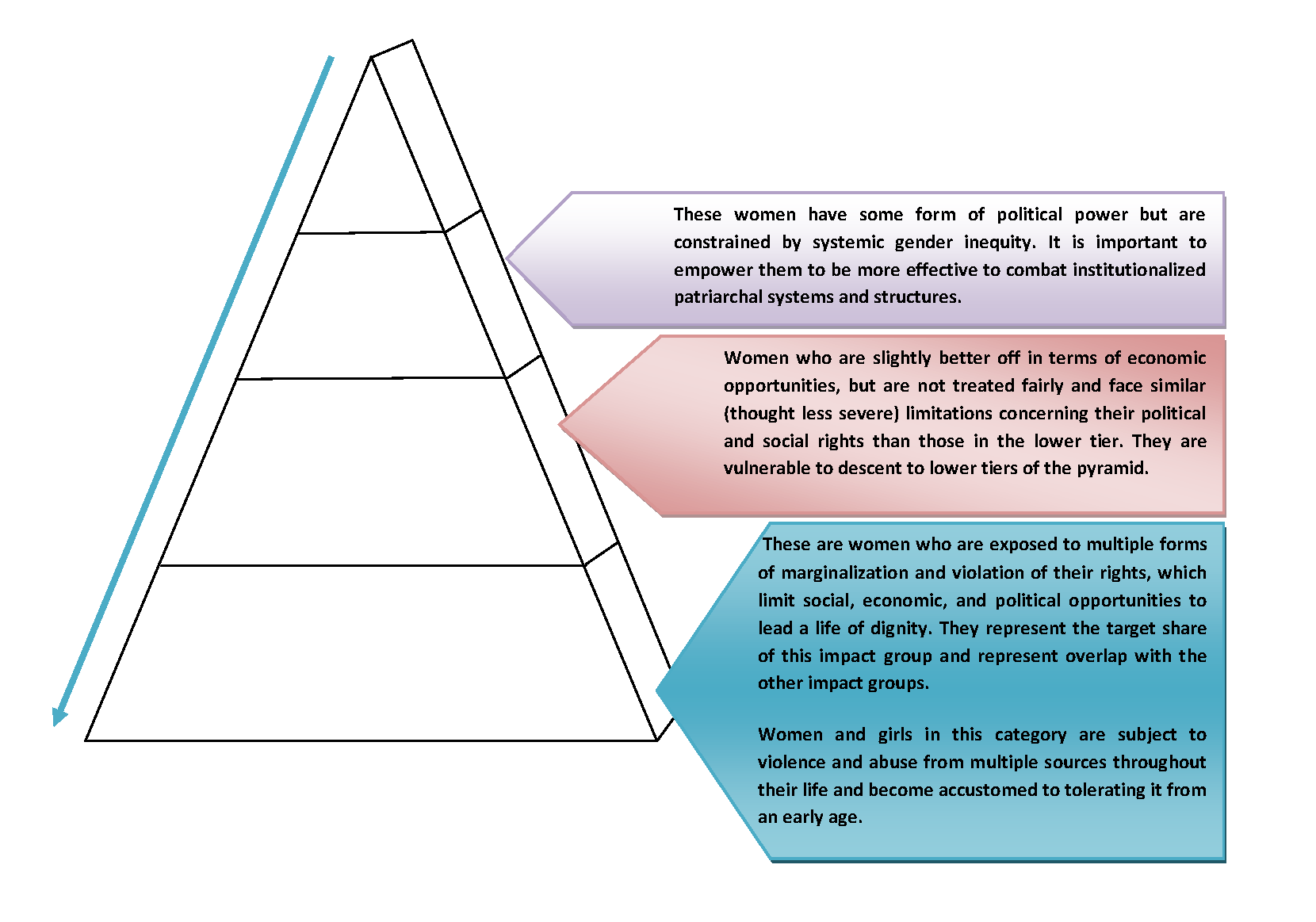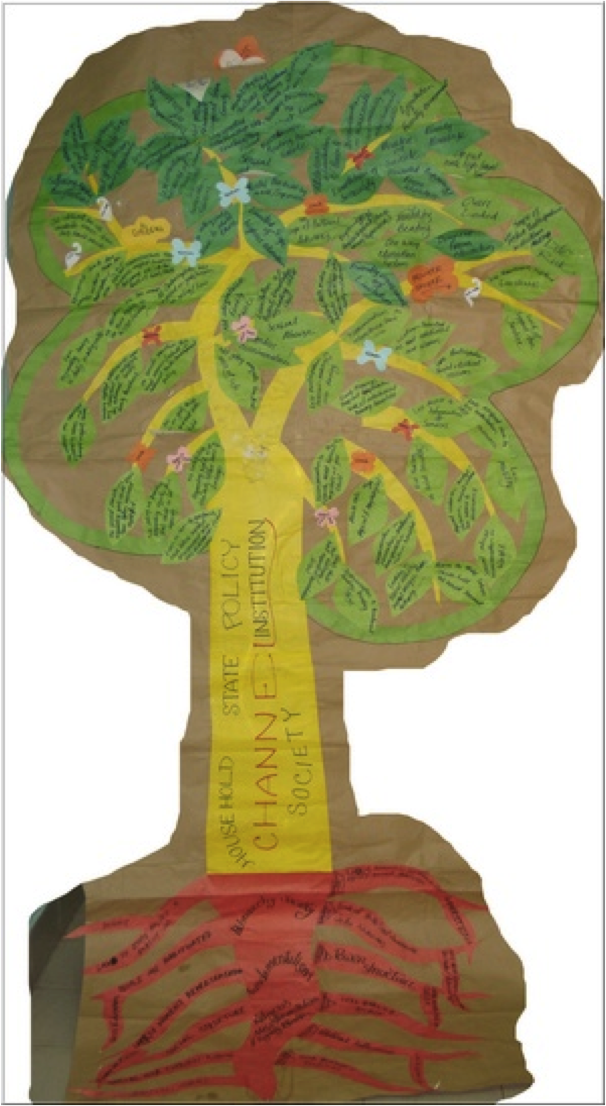Mapping Drivers of Poverty
Objective: To ensure that CARE’s new generation of programs are grounded firmly in a strong understanding of local contexts and realities.
Materials/Preparation: Idea cards, markers, one-page summary of underlying causes of poverty. At this point, teams should have reflected upon and researched on underlying causes of poverty affecting their impact population.
Participants: Staff and partners.
Steps
- Human Conditions/Agency: Quality of life and development
- Enabling Environment/Structures: The (public, private, civic, social) institutional environment, and its responsiveness and inclusiveness for growth and equity
- Social Positions/Relations: Power relations, social equity and inclusiveness
3. The facilitator also presents degrees of causes of poverty:
- Immediate causes or manifestations: Factors related directly to life and death, which include malnutrition, disease, etc.
- Intermediate Causes: Causes related to people’s well-being, which include access to basic services, lack of skills, lack of productivity, etc.
- Underlying Causes: Causes driving and perpetuating intermediate causes, usually related to the systems or rules that govern society – economic, political and social structures and beliefs that favor or exclude certain groups.
4. Based on these frameworks, the facilitator creates a matrix on the wall.
Human Conditions, Agency |
Enabling Environment, Structures |
Social Positions, Relations |
|
Immediate Cause, Manifestation |
|||
Intermediate Cause |
|||
Underlying Cause |
5. In plenary, participants take turns placing cards in the appropriate category, based on the questions:
- To which domain does each cause of poverty pertain? (Participants were explained that in many cases a certain cause of poverty cuts across several domains)
- At which degree (underlying, intermediate or immediate) does each cause of poverty belong?
6. Once this step is completed, participants cluster cards into categories, and the facilitator leads a discussion on what causes of poverty are particularly critical in perpetuating vulnerability among the impact group.
7. Based on consensus of key causes of poverty and the clusters of causes, participants then work in teams to develop domains of change.
8. These domains are then presented in plenary, where the team discussed, questioned and offered comments on the identified domains. Each domain was then revised and used as a basis for building program design (breakthroughs, pathways, strategies and indicators).
Related Tools
View more tools related to:
CARE Bangladesh - Causal Analysis
CARE Bangladesh was able to do this analysis through the cause-consequence tree analysis (below), the initial design for a project being conceptualized when the program theory of change was being done (i.e., the Partnership for Life – VAW Project), and prior literature reviews and discussions in the CO since 2002. Its engagement in the Strategic Impact Inquiry for Women’s Empowerment had already paved the way for this analysis. However, if the depth of analysis does not already exist in the CO, data gathering may be needed, as was done in Tanzania (see its UCP/V report as a basis for the impact group on women and girls).
There are three important steps and outcomes of this process:
- Identification of underlying causes of vulnerability for women and girls as distinct from men and boys
- An articulation of the physical, psychological, social, economic and political manifestations of vulnerability, marginalization, or exploitation
- Identification of groups (women and girls) and their characteristics for whom these vulnerabilities apply
In the case of CARE Bangladesh, the causes of vulnerability are:
- Unequal gender power relations
- Masculine systems and structures
- As a result of these two, a third cause: Access and control of resources and decisions
From birth, girls and boys are socialized into a patriarchal system of beliefs, values, and structures. This socialization shapes the respective capacities and attitudes of men and women, differentiating them by their gender, with a knock-on effect on their claims, rights and obligations.
Patriarchy pervades all aspects of life and that extends to the formal and informal institutions that individuals in the society draw upon. Power relations are the product of institutional practice.
The manifestations of marginalization and exploitation are shown in the table below:
Physical Manifestations
- At risk of physical, psychological and sexual violence and abuse (often dowry related)
- Poor reproductive, sexual and maternal health (evidenced by high maternal mortality and morbidity rates)
- High mortality rate among girls children
- Unequal care and practices for girls
- Deprived of basic needs and opportunities throughout the life cycles/stages
- Higher rate of malnutrition among girls and women relative to boys and men
- Higher workload relative to men
- Restricted mobility
- Physical safety often at risk in private and public domains
- Stigmatization of women who have sexually transmitted infections, or living with HIV and other diseases
Psychological Manifestations
- Poor self-esteem and lack of self confidence
- Poor perceptions of own agency and human potential
- Perpetual dependence on men
- Inability to protest about the injustice they experience
- Trauma from violence or abuse
Social Manifestations
- Discriminated for being single, divorced, or widowed
- Tolerance of violence
- Silence around domestic violence
- Lack of access to resources, services, assets for female headed households
- Exclusion and marginalization of married and unmarried adolescent girls
- Stigma faced by survivors of violence
- Less investment in the girl child by families and society
- Early marriage (with implications in physical, psychological and economic realms)
- False assumptions made about a woman who breaks social norms to access economic opportunity
Economic Manifestations
- Forced into sex work or other exploitative occupations
- Unfair compensation for young females garment workers and factory workers
- Migrant workers (unprotected by labor law)
- Maid servants (unfairly compensated and socially and psychologically abused)
- Independent women entrepreneurs disadvantaged
- Unemployed (lack of opportunities/ safety/ mobility)
Political Manifestations
- Few women are effective as political decision makers (e.g., women UP members)
- Women’s role as citizens is limited or not recognized
- Gaps in laws (or discriminatory laws, e.g. guardianship of children) that enable their misuse
- Improper implementation of laws in ways that discriminate women
- Lack of enforcement of laws related to dowry, early marriage, inheritance, etc.
- Lack of mechanisms to claim constitutional rights
And the groups and characteristics are illustrated by the pyramid below:

The tool below in the shape of a tree describes the root causes (roots of the tree) and the consequences of violence against women (VAW) (branches). This exercise was done with participants from three contributing projects (ARSHI, Protirodh and CEPZ) and became the basis for identifying pathways under the domain of change on VAW later.

Variations
Some teams also use the discussion on underlying causes to review their impact group definitions. For each identified cause of poverty, teams discuss what groups of people are most affected by it. Once all cards were discussed, teams then identify key groups who are particularly marginalized.
This exercise leads to a review of impact groups and sub-groups, and what value CARE could add in working with the identified groups based on a reflection of CARE’s experience working with the group/context as well as a review of other stakeholders active in the area.
Based on the discussion, participants work together to revise their impact groups and then developed domains of change.
Resources
- M Picard and S Gillingham (2012). Women's Empowerment Impact Measurement Initiative Guidance Materials.
- D Pinault (2010). Lignes Directives pour Travail de Groupe: Valider les domaines de changement et le but d’impact. CARE East and Central Africa Regional Management Unit.
- D Wu (2010). Making the P-Bouge Bouge: advancing, revisiting, revising, and advancing one again: CARE Burundi’s Program Shift Story. CARE Burundi.
- B Bode (2009). CARE Uganda Workshop to Define Impact Groups and a Theory of Change. CARE Uganda.
- M Drinkwater (2009). Brief #5: Designing Programs. CARE USA.
